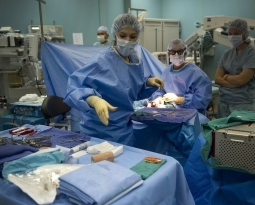New Hampshire Patent of the Month – January 2024
206 Ortho, Inc. has set a new standard in bone augmentation and fracture treatment with its innovative bone implant technology. This newly patented technology represents a significant leap forward in orthopedic solutions, promising enhanced performance and improved patient outcomes.
At the heart of this invention is a meticulously designed bone implant comprising a biocompatible, biodegradable polymer. The inclusion of a porogen, featuring fibers, distinguishes this implant, imparting a unique surface structure with pores smaller than 10 μm. These carefully engineered features play a pivotal role in facilitating osteoblast ingrowth and fostering the development of a scaffold for bone tissue regeneration.
The versatility of the bone implant is highlighted by its compatibility with various biocompatible and biodegradable polymers, including polyesters, polyvinyl alcohol, polyglycolic acid (PGA), polylactic acid (PLA), polyglycolic-lactic acid (PGLA), polyhydroxyvalerates, poly(amino acids), Chitin, Chitosan, polyhydroxybutyrates, polyethylene glycol, or their combinations. The patent also underscores the importance of specific monomers, such as lactic acid, glycolic acid, trimethylene carbonate, caprolactone, ethylene glycol, and propylene glycol, in achieving optimal performance.
A notable feature of the implant is its ability to form an interconnective pore structure through the degradation of the porogen, resulting in pores ranging from 10 to 500 μm. This carefully designed architecture provides a robust foundation for osteoblast ingrowth and bone tissue regeneration.
The bone implant from 206 Ortho goes beyond traditional solutions by offering support, stability, load-bearing capacity, and fixation for fractures. Its unique design dampens stress to prevent adjacent bone fractures while allowing controlled movement that promotes healing. The implant’s distinctive mechanical properties, characterized by a strain to yield of greater than 2.5% and a compressive stiffness of 14-20 GPa, position it as a formidable solution in orthopedic interventions.
The incorporation of a biologically active material for localized delivery, including targeted therapeutics and therapeutic agents like chemotherapeutic agents, elevates this bone implant to a comprehensive treatment solution. The controlled release of these therapeutic agents enhances the implant’s efficacy in promoting healing and combating infections.
206 Ortho’s patented bone implant represents a groundbreaking advancement in orthopedic R&D. With its meticulously designed features, compatibility with various polymers, and emphasis on biocompatibility and controlled drug delivery, this invention holds the promise of revolutionizing bone augmentation and fracture treatments, marking a significant milestone in orthopedic innovation.
Are you developing new technology for an existing application? Did you know your development work could be eligible for the R&D Tax Credit and you can receive up to 14% back on your expenses? Even if your development isn’t successful your work may still qualify for R&D credits (i.e. you don’t need to have a patent to qualify). To find out more, please contact a Swanson Reed R&D Specialist today or check out our free online eligibility test.
Who We Are:
Swanson Reed is one of the U.S.’ largest Specialist R&D tax advisory firms. We manage all facets of the R&D tax credit program, from claim preparation and audit compliance to claim disputes.
Swanson Reed regularly hosts free webinars and provides free IRS CE and CPE credits for CPAs. For more information please visit us at www.swansonreed.com/webinars or contact your usual Swanson Reed representative.

















